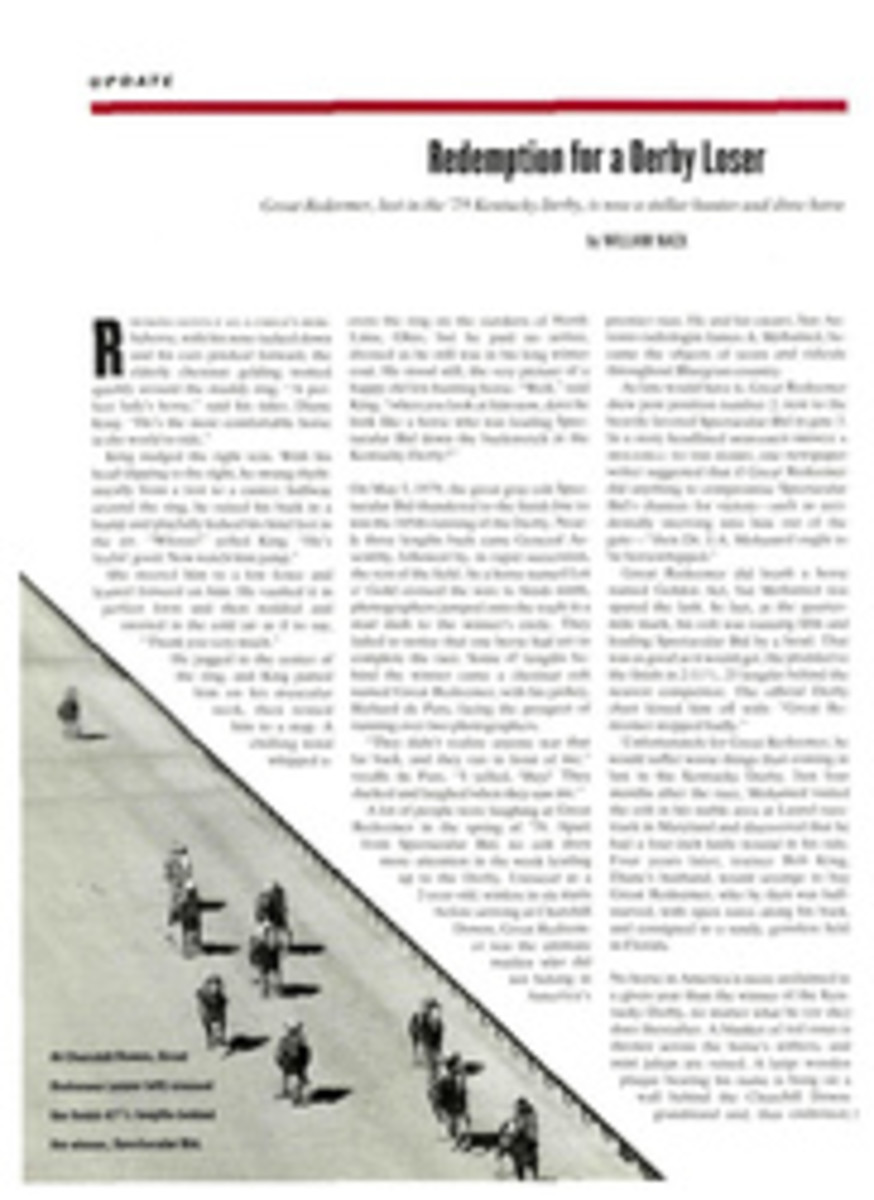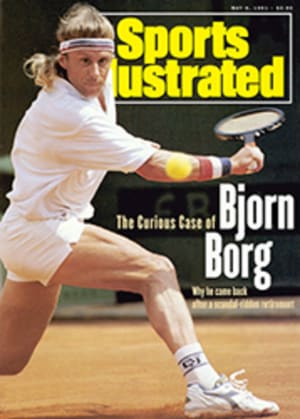
the young master
Slippery little suckers, aren't they?"
Twenty-year-old Phil Mickelson seems to be enjoying his first encounter with escargots, even if he hasn't yet gotten one in his mouth. The Arizona State junior is doing his best with snail tongs and a fish fork, but the buttery mollusks are in an unplayable lie. Other diners in the pricey Scottsdale, Ariz., restaurant are following his efforts closely; they may have to field a flying snail, a la the Julia Roberts scene in Pretty Woman.
"O.K., I eat the insides here?" asks Mickelson, who has finally coaxed the sluglike delicacy out of its shell and needs only a nod of assent to continue. Getting it, he pops the morsel into his mouth, chews tentatively and nods. "They're good. They're really good," he says.
He eats a second snail, and then a third. The folks at adjoining tables begin to relax. "I wonder how hard the shells are," says Mickelson. "Probably can't break 'em. I guess if you could squeeze 'em with this guy...." A shell suddenly squirts out of his tongs and rattles against its neighbors on the plate. Heads turn. Mickelson smiles sheepishly.
Amazing what you can learn about a fellow by putting him in front of a plate of snails. From this episode, one gathers that Mickelson is curious, playful, unsophisticated, adventurous (he ordered the snails) and not the least bit self-conscious. Of course, you could have concluded most of that in mid-January, just by picking up the sports pages and reading COLLEGE GOLFER WINS PGA TOUR EVENT, or by seeing his happy puss photographed under a conquistador's helmet, his trophy for winning the Tucson Open. Another hint came on the April cover of Golf Digest, which showed Mickelson, who plays lefthanded, demonstrating his patented backward-over-your-head greenside wedge shot.
He is already the most conspicuous American amateur since Bobby Jones. At the Masters three weeks ago, Mickelson shot a 69 in his first competitive round at Augusta National and found himself sharing the press-center podium with Jack Nicklaus. His four-round total of 290, two over par, earned him the silver cup for being low amateur. On May 16, with his eyes still puffy from college finals, he will tee up with the pros at the Memorial Tournament in Dublin, Ohio, his sixth pro tournament of the year. He has won three college tournaments this spring—in three attempts—and, if all goes according to plan, by summer's end he will have successfully defended his NCAA and U.S. Amateur titles, played in the U.S. Open and the British Open, and anchored the American team in its bid to wrest back the Walker Cup from the British and the Irish.
Is it surprising, then, that Mickelson's visibility does not extend to the classroom, where his trademark this spring was the empty seat? "My husband and I were both concerned about the amount of school he was missing," says his mother, Mary, an Escondido, Calif., retirement-home marketing director. "But he turns in his papers early and works out what will be covered with his professors. I thought it was going to be harder for him than it actually was."
"I think there are enough hours in the day to do what he wants to do," says his longtime girlfriend, sometime caddie and Arizona State classmate, Tana (I Knew Him Before He Was Good) Figueras. "He's a very focused and driven person."
Mickelson, a psychology major with a 3.0 grade point average, makes light of the demands on his time. Asked what he does on a typical school day, he says, "At 6:30 I watch Cheers. At 10 o'clock I watch Cheers. And on Thursdays, at 6:30, 8 and 10, I watch Cheers. Monday and Wednesday I do some homework."
In truth, Mickelson is no stranger to all-nighters, and he toted a Spanish textbook to this year's Tour events. "Spanish is the easiest course I have, because I don't have to be there to learn it," he says. "I had a really good Spanish teacher in high school, so a lot of this stuff's just review for me."
The question that dogs him is, Why stay in school at all? If he had turned pro before Tucson, Mickelson would have nearly $200,000 in tournament winnings to this point, with more to be made from corporate outings and endorsements. Instead, he flies around the country on an airline pass (his dad, who's retired, used to be a Republic Airlines pilot), stays in private homes during tournaments, and carries his own bag, as required, in college tournaments. In March, while his classmates were spending spring break in Palm Springs, Calif., and Rocky Point, Mexico, Mickelson stayed behind to play golf and study. But come on, could he really have studied while a crew from the video magazine The Wide World of Golf set up camera equipment under the beer-can mobile in his Tempe apartment?
"There are a couple of points here," he says, turning serious. "School is a commitment I made, and I don't feel that the degree [which he plans to get in the spring of 1992] is as important as fulfilling my commitment. That's the primary reason I'm staying. As for golf, I kind of set a four-year plan. I felt that in four years I could advance my game and be strong enough to compete on the PGA Tour. I'm three years through that, and the opportunity to play in Tour events is just helping me get acclimated while I'm in college. Does that make sense?"
Mickelson also wants to put his name on a few more lines of the amateur record book before he goes after the big money. Last summer, he matched Nicklaus's achievement of winning the U.S. Amateur and the NCAA championships in the same year. If he wins this year's NCAA on June 8 at Poppy Hills in Pebble Beach, Calif., Mickelson will join Ben Crenshaw as the only three-time NCAA winner, and he'll have a chance to win an unprecedented fourth as a senior.
"To be part of amateur golf history means a lot to me," he says. "I'm really intrigued with Bobby Jones. He was the greatest amateur golfer of all, and winning the U.S. Amateur, I felt closer to his mystique. Golf is built around, and always will be built around, the amateur."
That sort of talk causes a joyful flutter in the hearts of U.S. Golf Association officials, but Mickelson's practiced humility leads cynics to question his sincerity. "Is he for real with all this 'love of the game' stuff?" says one golf writer. Says another, "He acts like a guy who's trying to impress a girl's parents before taking her out on a date."
Mickelson is sensitive to the notion that his demeanor is as carefully coached as his swing. However, he makes no bones about one thing: He is polishing his act. "A golfer is an entertainer, much like an actor," he says. "People pay money to go out and watch you play, and I don't think they pay just to watch you hit a drive down the middle, hit a shot on the green and two-putt. That's why Lee Trevino and Fuzzy Zoeller are so popular. They are entertainers as well as golfers."
Mickelson's shtick is subtle, so far; you can't imagine him showing up at the first tee with a rubber snake, as Trevino did at the 1971 U.S. Open. He's polished. The kid has his turned-up collar, his deft way of twirling the club head during his pre-shot routine, his lounge-singer's trick of smiling and nodding acknowledgment in all directions after a good shot. So ingrained is this last habit that Mickelson walked onto a green at the San Diego Open in February, nodding left and right—and the gallery hadn't begun applauding yet.
"It's not flippant, it's not aloof," says PGA Tour official and Walker Cup player David Eger, who lost to Mickelson in the semifinals of last year's Amateur at Cherry Hills in Denver. "It's the cockiness Lanny Wadkins had back in the '70s, when he was in college. Phil doesn't bother anyone. He can back it up."
Little wonder that Mickelson drew the biggest galleries at Cherry Hills, or that he had more fans than Nick Faldo when he was paired with Faldo, the defending Masters champion, for the first round at Augusta. Mickelson wants not only to win but also not to disappoint. "Phil is like Arnold Palmer," says his longtime teaching pro, Dean Reinmuth, "in that he doesn't just like to play golf; he likes to play golf when people are there."
Reinmuth, who sometimes caddies for his pupil, recalls an incident at the Los Angeles Open: Mickelson hit a shot into the crowd near an access road. "Just as he's getting set to hit," says Reinmuth, "he looked up and said, 'You might want to move back; you never know.' And nobody moved. So he got set up again and was ready to hit it, when everybody decided, 'Hey, that's a great idea,' and they all shifted at the same moment. Phil just laughed and said, 'Well, you don't all have to move, I'm not that bad.' He has a natural playfulness because he likes people and he loves to play golf."
Mickelson is a big hitter with go-for-it tendencies, and that doesn't hurt with the galleries either. The strengths of his game, though, are wedge play and putting, both honed on the practice green his father built behind their San Diego home 20 years ago. No one hits greenside lobs with more confidence than Mickelson, who can drop the ball in a grasshopper's pocket anywhere inside 30 yards. His full swing is unfashionably long and loose at the top, but Reinmuth says Mickelson's occasional wildness owes more to a tendency to "get fast" than to wristiness.
"Phil's at a point now where he basically teaches himself," says Reinmuth. "When he has trouble, he just has to come back and check out the parameters we established a long time ago."
Is guts a parameter? In the final round at Tucson, leading by a stroke, Mickelson shot a snowman in the desert—a triple bogey 8 on the 14th hole at the TPC at StarPass. He could have melted away himself, but Mickelson birdied 16 and 18 to edge Tom Purtzer and Bob Tway by a stroke. "I've never seen anyone come back from something like that," said Tour veteran Corey Pavin, who played with Mickelson in the final group.
It's all school for Mickelson. He prepared for the Masters by studying tapes of Nicklaus winning his sixth green jacket, in 1986. He reviews his press conference answers with his college coach, Steve Loy, striving for the right blend of humility and sassiness. The major championships, the Tour events, are for now simply laboratories where Mickelson can gain confidence and measure progress. There's no hurry to be the next Nicklaus, the next Palmer, the next anybody.
"When I was five years old," says Mickelson, "I played because I wanted to, not because 15 years down the road I'd have a chance to turn pro and make a couple of hundred thousand dollars."
Mark 'em down. They are the words of a young man racing toward certain fame and fortune, but at a snail's pace.
TWO PHOTOS
JACQUELINE DUVOISIN
With his turned-up collar and ready smile, Mickelson was as adroit in front of the camera at Augusta National as he was on the fairways.
PHOTO
JACQUELINE DUVOISIN
Mickelson got an early read on the Masters, where he shot a 69 in the opening round.
PHOTO
JOHN W. MCDONOUGH
To Figueras, Mickelson is a "focused and driven person."

